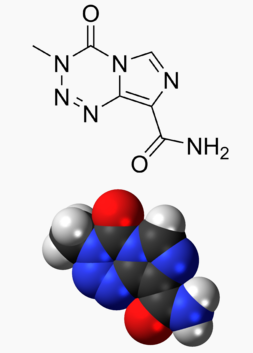Temozolomide
 | |
| Clinical data | |
|---|---|
| Routes of administration | Oral |
| ATC code | |
| Legal status | |
| Legal status |
|
| Pharmacokinetic data | |
| Protein binding | 15% |
| Metabolism | spontaneously hydrolized at physiologic pH to the active species, 3-methyl-(triazen-1-yl)imidazole-4-carboxamide (MTIC) and to temozolomide acid metabolite. |
| Elimination half-life | 1.8 hours |
| Identifiers | |
| |
| CAS Number | |
| PubChem CID | |
| DrugBank | |
| E number | {{#property:P628}} |
| ECHA InfoCard | {{#property:P2566}}Lua error in Module:EditAtWikidata at line 36: attempt to index field 'wikibase' (a nil value). |
| Chemical and physical data | |
| Formula | C6H6N6O2 |
| Molar mass | 194.151 g/mol |
|
WikiDoc Resources for Temozolomide |
|
Articles |
|---|
|
Most recent articles on Temozolomide Most cited articles on Temozolomide |
|
Media |
|
Powerpoint slides on Temozolomide |
|
Evidence Based Medicine |
|
Clinical Trials |
|
Ongoing Trials on Temozolomide at Clinical Trials.gov Clinical Trials on Temozolomide at Google
|
|
Guidelines / Policies / Govt |
|
US National Guidelines Clearinghouse on Temozolomide
|
|
Books |
|
News |
|
Commentary |
|
Definitions |
|
Patient Resources / Community |
|
Patient resources on Temozolomide Discussion groups on Temozolomide Patient Handouts on Temozolomide Directions to Hospitals Treating Temozolomide Risk calculators and risk factors for Temozolomide
|
|
Healthcare Provider Resources |
|
Causes & Risk Factors for Temozolomide |
|
Continuing Medical Education (CME) |
|
International |
|
|
|
Business |
|
Experimental / Informatics |
Please Take Over This Page and Apply to be Editor-In-Chief for this topic: There can be one or more than one Editor-In-Chief. You may also apply to be an Associate Editor-In-Chief of one of the subtopics below. Please mail us [1] to indicate your interest in serving either as an Editor-In-Chief of the entire topic or as an Associate Editor-In-Chief for a subtopic. Please be sure to attach your CV and or biographical sketch.
Overview
Temozolomide (brand names Temodar and Temodal (Schering-Plough Corporation) is an oral alkylating agent used for the treatment of refractory anaplastic astrocytoma -- a type of cancerous brain tumor. A derivative of imidazotetrazine, temozolomide is the prodrug of MTIC (3-methyl-(triazen-1-yl)imidazole-4-carboxamide). It has been available in the US since August 1999.
Indications
- Anaplastic astrocytoma: for the treatment of adult patients with refractory anaplastic atrocytoma (ie. patients who have experienced disease progression on a drug regimen containing nitrosourea and procarbazine).
- Unlabeled uses: Metastatic melanoma.
Temozolomide is an imidazotetrazine derivative of the alkylating agent dacarbazine. It undergoes rapid chemical conversion in the systemic circulation at physiological pH to the active compound, MTIC (monomethyl triazeno imidazole carboxamide). Temozolomide exhibits schedule-dependent antineoplastic activity by interfering with DNA replication. Temozolomide has demonstrated activity against recurrent glioma. In a recent randomized trial, concomitant and adjuvant temozolomide chemotherapy with radiation significantly improves progression free survival and overall survival in glioblastoma multiforme patients.
The most common non-hematological adverse effects associated with temozolomide were nausea and vomiting and were either self-limiting or readily controlled with standard antiemetic therapy. These effects were usually mild to moderate (grade 1 to 2). The incidence of severe nausea and vomiting is around 4% each. Patients who have pre-existing or a history of severe vomiting may require antiemetic therapy before initiating temozolomide treatment. Temozolomide should be administered in the fasting state, at least one hour before a meal. Capsules must not be opened or chewed, but are to be swallowed whole with a glass of water. Antiemetic therapy may be administered prior to, or following, administration of temozolomide. Temozolomide is contraindicated in patients with hypersensitivity to its components or to dacarbazine. The use of temozolomide is not recommended in patients with severe myelosuppression. Temozolomide is genotoxic, teratogenic and fetotoxic and should not be used in pregnancy. Nursing should be discontinued while receiving the drug because of the risk of secretion into breast milk. In male patients, temozolomide can have genotoxic effects. Men are advised not to father a child during or up to six months after treatment and to seek advice on cryoconservation of sperm prior to treatment, because of the possibility of irreversible infertility due to temozolomide therapy.
Formulations
Temozolomide is available in the United States in 5mg, 20mg, 100mg, 140mg, 180mg & 250mg capsules.
External links
- Chemotherapy Drug Shrinks Brain Tumors American Academy of Neurology, May 21, 2007
- Pages with script errors
- E number from Wikidata
- ECHA InfoCard ID from Wikidata
- Articles without EBI source
- Chemical pages without ChemSpiderID
- Articles without KEGG source
- Articles without InChI source
- Articles without UNII source
- Articles containing unverified chemical infoboxes
- Chemotherapeutic agents
- Prodrugs